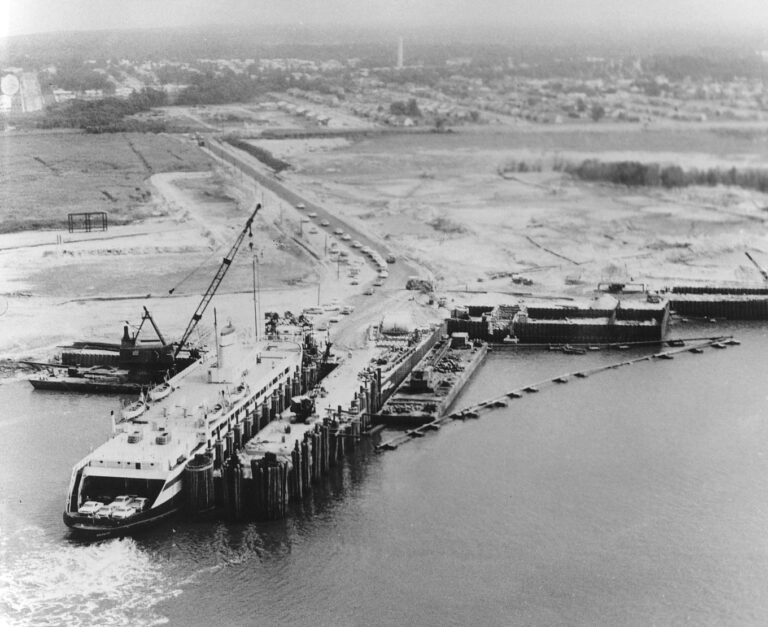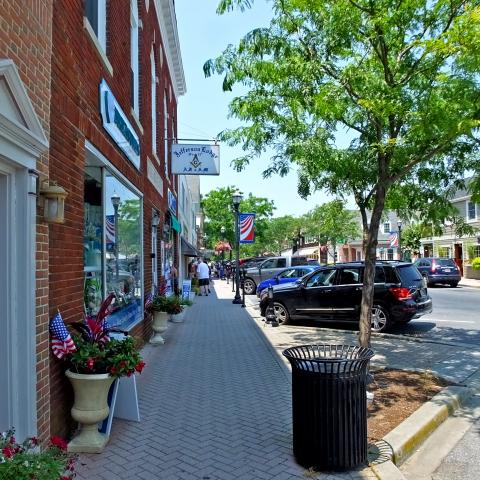A VITAL LINK: A Deeper Look At The Economic Impact of the Cape May-Lewes Ferry Image
It used to be a dead end. Those reaching the end of southern New Jersey had to be satisfied with Cape May, as anything across the Delaware Bay was a mystery—or a long car ride away. All that changed in 1964, and over the ensuing 59 years, the Cape May-Lewes Ferry has done more than just serve as an extension of Route 9. Today, it helps promote a free flow of people, vehicles and goods between the two destinations—and up and down the East Coast.
For nearly 60 years, the Cape May-Lewes Ferry has helped foster the free flow of humanity and commerce along the East Coast.
“Before the Ferry, the Delaware and southern New Jersey coastal communities, including Cape May and Lewes, were somewhat isolated,” says Delaware River and Bay Authority Executive Director Thomas J. Cook*. “With the advent of the Ferry, a north-south water highway was established, which spurred economic growth and development on both sides of the Delaware Bay. The Ferry is so much more than just a means of transportation.”

The Ferry did its part to foster the revitalization of Cape May, Lewes and the surrounding areas. Today, it serves as a centerpiece for tourism, commerce and special events for thousands of people each year. The Ferry is more than that three-hour round trip across the bay. It’s a vital connection. It brings people to Lewes to shop at the outlets and visit nearby coastal towns like Rehoboth Beach. It takes them to Cape May to visit the zoo, eat at the many restaurants in town, visit nature preserves and hit the beaches. The populations of the two towns have grown—in part, because people in New York, north and central New Jersey and Pennsylvania have access to Delaware towns, and those living in the First State, Maryland and Virginia have easier access to Cape May. “People can have second houses and condos in those areas because of the Ferry,” Cook says.
The Ferry makes the Twin Capes experience richer and more convenient. People who come to South Jersey Shore towns for a week may hit the boardwalk in Wildwood and also experience the whale watch off of Cape May. Those who visit 388-year-old Lewes can enjoy its historic district, visit the museums and experience Cape Henlopen State Park. “It’s an interesting crossing,” says Cook. “It’s one of the most heavily traveled shipping channels on the Eastern Seaboard. You’ll see oil tankers and container ships. There are historic lighthouses on both sides. It’s a path for migrating birds, and you might just see some dolphins and whales.”

The Ferry is an important part of a regional commercial transportation system used by businesses to move goods efficiently from New Jersey to southern Delaware, Maryland, and Virginia. A variety of products can be found on vehicles using the Ferry, including food and home goods. The Ferry also assists in marine mammal rescue operations. And it provides transportation for Coast Guard land transports between its training center in Cape May and the Norfolk area. People have even moved houses on the Ferry. Eighteen wheelers use it. If it’s shorter than 13 feet, 6 inches and not too wide, it can ride along.
With their beautiful waterfront locations, the two Ferry terminals host events throughout the year—everything from birthday parties, family reunions and weddings to craft shows, festivals and sporting events. The Lewes Sea Glass Festival brings 6,000 people to the Delaware terminal each June, and the Escape the Cape Triathlon boasts competitors from 40 different states, kicking off with a 12-foot jump off the Ferry. “Part of the mission of the Ferry is economic development,” Cooks says. “People come to the events and stay in hotels, eat in restaurants and visit shops.”
On both sides of the bay—thanks to the Ferry.
*Thomas J. Cook was the Executive Director of the DRBA until June 2025.
This listing originally appears in the Spring/Summer 2019 edition of Twin Capes Traveler, a joint travel digest produced by Today Media, Today Media Custom Communications and the Cape May-Lewes Ferry.

Ready to sail?
Whether you’re traveling for leisure, business, or pure curiosity, the Cape May–Lewes Ferry offers a memorable, stress-free way to travel the Delaware Bay — with comfort, community, and coastal charm built into every crossing.
- Cape May Things to Do
- Lewes Things to Do
